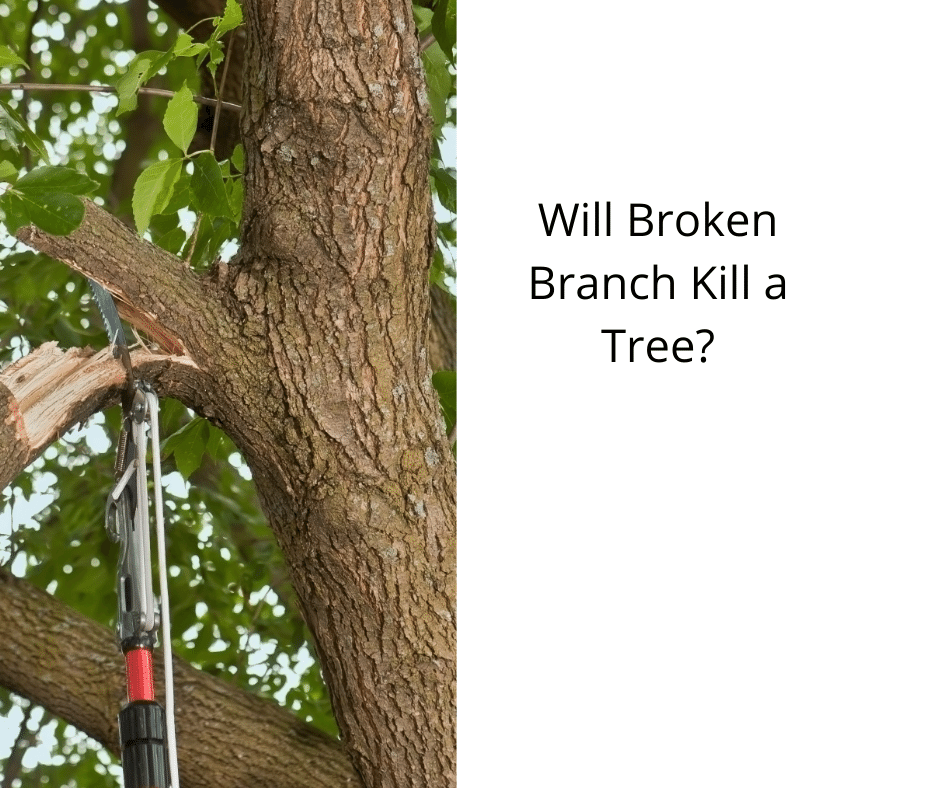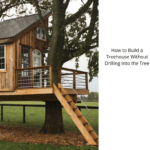Beginners Guides
Will Broken Branch Kill a Tree?

Damaged branches pose a risk and could ultimately result in your tree perishing. It’s important to understand that trees will bow under the excessive weight of snow and ice. Should the damage to the branches be minimal and less than half of the crown be affected, there’s a good chance your tree will heal. However, this will require your patience. It’s not possible to assist the tree amidst a snowstorm or in the immediate days thereafter. If you’re uncertain about the next steps, it’s advisable to consult with a specialist who can examine your tree and provide an assessment.
Breaking Branches Can Kill a Tree
While large broken branches may not kill a tree, the wound is not always as superficial as it appears. A broken branch will open up the tree to more damage and disease. A tree owner can use a substance such as mud to cover the wound. Otherwise, the tree may die. Here are some tips to prevent a tree from dying from a broken branch. After a storm, a tree is more likely to be healthy than before.
Check for dead wood in the tree’s crown. Deadwood in trees is easy to detect because it has either no leaves or brown color. Pine branches that have recently died will have brown needles. Broken branches are visible when they are no longer green or have yellow color on them. Breaking branches can be dangerous, but you might not realize it until the leaves turn brown. If the branches are dead, call an arborist immediately.
Don’t cut limbs too close to the tree’s trunk. This can allow insects and diseases to enter the wound. The tree’s bark will be exposed, and moisture and rot can set in. The cut will also be less likely to heal if the limb is too close to the trunk. So, it is essential to cut only the branch that has fallen off or is close to its base.
Depending on the extent of the damage to the tree’s trunk, it is possible to make it recover. The damaged area is called the cambium layer. The cambium tissue provides nutrients and water to the tree. It is important for the tree to receive enough nutrients to stay healthy. If it suffers a serious injury, it may not survive. If you want to avoid tree damage, be sure to hire an arborist.
The best way to prevent roots from being cut is to prune the branches before they fall to the ground. Avoid trimming heavy branches at the base of the tree, as they can cause harm to people and other plants. Heavy branches can also damage lawns and planting beds. A large branch may even be a sculpture. If you have to cut a large branch, consult an arborist and get the tree checked by a professional.
Symptoms
There are three main symptoms of a dying or dead tree. These include wilted leaves and broken branch symptoms. While small wounds to a tree’s trunk are not fatal, they may act as entry points for fungi and cause decay in the tree later. Larger wounds, more than 50% of the tree’s diameter, are serious and can kill the tree. In order to avoid this situation, a tree should be pruned back to the main branches.
Another sign of dying or dead wood is large, flaking branches. Sometimes, branches grow so close to each other that they do not anchor appropriately to the trunk. The bark will sag in between the branches, creating a weak bond. Ideally, the bark on a tree is smooth and continuous, without deep cracks. Any signs of decay are a red flag. A dying tree will begin to die from the inside out, so you should look for other signs of deterioration, such as fungus and mushrooms. Discolored leaves and wood are also a red flag.
Another warning sign of a dying tree is missing bark. If you see any of these symptoms, it’s best to take it seriously. A missing branch is a sign of a fungus or a surface wound. A tree with bark flaking will have an infected surface, which will be covered by a layer of sap. It’s important to inspect the tree’s trunk to ensure there are no insects living inside.
If you have questions or want to hire a professional arborist, remember to consult a certified arborist. Their knowledge and experience can help you identify the problem and determine the best course of action. Broken branches are often the result of structural imbalance or general weakness. A tree that is leaning more than fifteen degrees may have been injured by wind and will not recover. It will die in the long run. When this happens, it is time to remove the tree.
If you notice a tree has multiple trunks, look for cracks at the connection between the trunks. Strong connections are a “U” shape, and weak connections resemble a tight “V.” Cracks in the connection are a sign of weakness, and should be looked at immediately. If you live near a tree, you should take a look at the connection using binoculars to identify fresh cracks. Light-colored lines indicate a fresh crack. If you notice any of these signs, you should immediately call a Certified Arborist or tree service to help you identify the tree’s cause.
Treatment
You may think that a broken branch will kill a tree. You might not be sure, but it’s not entirely true. Although a broken branch can leave the tree looking naked, it won’t kill it. It will merely grow differently. Broken branches can open up the tree to disease and other damage. You can get rid of broken branches yourself, or you can hire a professional to prune the tree for you.
Firstly, you can remove dead branches from the tree. Be sure to remove them carefully so that the decay agents do not enter the wound. If you need to prune the branches, trim them at the point where they join the main branches. If you need to cut the branches, consult an arborist, as it’s best not to cut any smaller branches. It may also be necessary to remove soil from the base of the tree, as it can harbor phytophthora root rot, which is a widespread soil pathogen.
If the broken branch is too close to the trunk, you should prune it back to a good size lateral branch. If the branch breaks near the trunk, prune it back to the branch collar, which is a slightly-enlarged region where the branch joins the trunk. This support is important to prevent the broken branch from damaging the trunk. After cutting back the broken branch, you should remove any dead branches from the tree.
Another way to kill a tree is to cut off its surface roots. These roots provide vital support to the tree. During construction, they are often cut off or damaged. While a tree can recover from a 25% injury, a limb that has suffered severe damage is likely to starve. In addition, serious trunk injuries can starve the tree of water and nutrients. This is not a good thing for the tree.
In addition to damage caused by storms, broken branches can also be the result of underlying problems. The weight of too much fruit on a tree’s limbs can cause the limbs to break off. If these problems are not resolved, the tree can succumb to disease and decay. The weight of too many small branches on a single branch can also put strain on the branch. Judicious thinning of fruit can help avoid these problems and encourage a healthy tree.
Cost
It’s important to know that damaged trees cost money to replace. While the initial costs are relatively small, the replacement cost may be as much as three times that amount. Replacement costs vary widely depending on the type and size of the tree. However, a typical tree replacement costs $500 to $3000. Some rare trees can cost tens of thousands of dollars. Here’s what to do if you notice that a branch has broken.
Pruning your trees is an important process for keeping your trees healthy. Incorrect pruning can make your trees more susceptible to decay and disease. Ultimately, improper pruning can kill your tree. However, if you’re unsure about how to prune your trees, you can always call a professional to do it for you. It’s cheaper and less stressful than attempting to prune your trees yourself. Broken branches and dead branches should be removed to avoid these problems.
Hi, I’m Emma. I’m the Editor in Chief of Tiny House 43, a blog all about tiny houses. While tree houses are often associated with childhood, they can be the perfect adult retreat. They offer a cozy space to relax and unwind, surrounded by nature. And since they’re typically built on stilts or raised platforms, they offer stunning views that traditional homes simply can’t match. If you’re looking for a unique and romantic getaway, a tree house tiny house might just be the perfect option.
Beginners Guides
How Big Are Windows In A Tiny House

Were you aware that windows could constitute as much as 15% of a tiny house’s total square footage? This represents a considerable portion of space allocated for the introduction of natural light and to foster a feeling of spaciousness within these small living quarters.
When it comes to choosing the size of windows for a tiny house, several factors need to be considered. In this article, I will explore the common window sizes for tiny houses, ways to maximize natural light, and how to balance privacy and views. I will also discuss important safety considerations and provide insights into different window styles and designs.
Whether you are building or renovating a tiny house, choosing the right window size is crucial for creating a functional and visually appealing space. So, let’s dive in and discover the world of windows in tiny houses!
Key Takeaways
- Windows can make up to 15% of the total square footage in a tiny house.
- Common window sizes for tiny houses range from 24×24 to 36×36 inches.
- Popular window options for maximizing natural light in tiny houses include casement windows, awning windows, and picture windows.
- Balancing privacy and views can be achieved through window coverings such as blinds, curtains, or frosted glass.
Factors to Consider When Choosing Window Size
When choosing window size for your tiny house, you’ll want to consider factors such as the amount of natural light you desire and the overall aesthetic you’re aiming for. Maximizing ventilation and energy efficiency are also important considerations.
The size of your windows can greatly impact the amount of natural light that enters your space. Larger windows will allow more light to filter in, creating a bright and airy feel. However, larger windows may also result in more heat loss during the colder months, so it’s important to choose windows with good insulation properties.
Additionally, you’ll want to consider the overall aesthetic of your tiny house. Smaller windows can give your home a cozy and intimate feel, while larger windows can make the space feel more open and spacious.
Transitioning into the subsequent section about common window sizes for tiny houses, it’s important to find a balance between natural light, ventilation, energy efficiency, and the overall look and feel of your tiny home.
Common Window Sizes for Tiny Houses
If you’re planning to build a small home, you’ll be amazed by the average size of windows commonly found in these cozy dwellings. Tiny houses often feature windows that are smaller than those in traditional homes, but they still provide ample natural light and enhance the overall aesthetic appeal.
The most common window sizes for tiny houses range from 24 inches by 24 inches to 36 inches by 36 inches. These sizes are popular because they strike a balance between maximizing natural light and maintaining structural integrity.
When choosing window styles and designs for your tiny house, consider options like casement windows, awning windows, or picture windows to maximize natural light and create a visually pleasing space. By carefully selecting the right window sizes and styles, you can create a bright and inviting atmosphere in your tiny house, making it feel more spacious than it actually is.
Transitioning to the next section, let’s explore some strategies for maximizing natural light without compromising privacy.
Maximizing Natural Light
To truly enhance the ambiance and create a sense of openness, it’s important to strategically harness the power of natural light in your compact living space. Maximizing natural light can make your tiny house feel larger and more inviting.
Here are five ways to achieve this:
- Consider the orientation of your windows to ensure maximum sunlight exposure throughout the day.
- Use lighter paint colors on walls and ceilings to reflect and amplify natural light.
- Opt for larger windows or install skylights to bring in more light.
- Avoid obstructing the windows with furniture or curtains that block sunlight.
- Use mirrors strategically to bounce light around the room and create the illusion of a larger space.
By carefully planning your window placement and utilizing these tips, you can make the most of natural light in your tiny house. Balancing privacy and views is the next important aspect to consider.
Balancing Privacy and Views
When it comes to balancing privacy and views in a tiny house, there are several options for window coverings that can provide the necessary privacy while still allowing for a view of the outside.
Some popular types of window coverings for privacy include blinds, curtains, and frosted or privacy glass. Additionally, there are creative solutions available that can help maintain views while preserving privacy, such as using sheer curtains or installing window film that allows for one-way visibility.
It’s important to consider both functionality and aesthetics when choosing window coverings in order to create a comfortable and practical living space.
Types of window coverings for privacy
Window coverings in a tiny house add a touch of coziness and ensure privacy, making it feel like a true home. When it comes to choosing window coverings, it’s important to find a balance between maximizing natural light and maintaining privacy. There are various types of window coverings that can achieve this balance.
Here is a table showcasing three popular options:
| Window Covering | Pros | Cons |
|---|---|---|
| Blinds | Allow for adjustable privacy | Can be difficult to clean and may block some light |
| Curtains | Offer a soft and elegant look | Require more space to install and can block light |
| Frosted Glass | Provide privacy while letting in light | Limits visibility and can be expensive |
By considering these options, you can find the perfect window coverings that suit your needs in terms of privacy and natural light. In the next section, we will explore creative solutions for maintaining views while preserving privacy.
Creative solutions for maintaining views while preserving privacy
When it comes to window coverings for privacy in a tiny house, there are numerous options available. From curtains and blinds to frosted glass and window films, you can choose the solution that best fits your needs and style.
However, if you also want to maintain your views while preserving privacy, there are some creative solutions to consider. One possibility is using sheer curtains that allow light to filter through while still providing a level of privacy. Another option is installing window shutters that can be adjusted to control both light and privacy. Additionally, choosing the right window styles and designs can help maximize natural light while ensuring privacy. For instance, installing larger windows or adding skylights can bring in more sunlight while maintaining your privacy.
As we move forward, let’s explore some important safety considerations to keep in mind when designing your tiny house.
Safety Considerations
When it comes to safety in a tiny house, two key points to consider are emergency exits and egress requirements, as well as security measures for windows.
It is crucial to have a clear plan for emergency situations, ensuring that there are accessible and properly sized exits to allow for a quick escape.
Additionally, implementing security measures for windows, such as sturdy locks and shatter-resistant glass, can help prevent break-ins and provide peace of mind.
By addressing these safety considerations, we can ensure a secure and protected living environment in a tiny house.
Emergency exits and egress requirements
To ensure your safety, it’s important to consider the size of emergency exits and meet the egress requirements in your tiny house. When it comes to window size regulations, there are a few key things to keep in mind:
-
Adequate size: Emergency exits should be large enough for a person to easily crawl through. Check your local building codes for specific requirements.
-
Accessibility: Make sure emergency exits are easily accessible and not obstructed by furniture or other objects.
-
Visibility: Consider using windows that provide ample natural light and clear views to help in emergency situations.
-
Security: While it’s important to have emergency exits, it’s also crucial to ensure they’re secure to prevent unauthorized access.
By following these guidelines, you can ensure that your tiny house meets the necessary safety standards for emergency exits.
Now let’s discuss the security measures for windows in a tiny house.
Security measures for windows in a tiny house
Implementing proper security measures for the windows in a compact dwelling is essential to ensure the safety and protection of its occupants. In a tiny house, where space is limited, it is crucial to maximize security features without compromising aesthetics or functionality. Regular window maintenance is also important to keep the windows in good condition and prevent any vulnerabilities. Here is a table showcasing three effective security measures for tiny house windows:
| Security Measure | Description | Benefits |
|---|---|---|
| Window Alarms | These devices emit a loud sound when the window is opened or tampered with, alerting the occupants and deterring intruders. | Increased security and peace of mind. |
| Reinforced Glass | Utilizing laminated or tempered glass can make it more difficult for burglars to break into the house through the windows. | Enhanced resistance against forced entry. |
| Window Locks | Installing sturdy locks on the windows adds an extra layer of protection, preventing unauthorized access. | Improved security and control over who can enter the house. |
In addition to these security measures, regular window maintenance, such as cleaning and inspecting for any damage or wear, is essential to ensure their effectiveness. With proper security measures in place, we can now explore different window styles and designs for a tiny house.
Window Styles and Designs
One popular window style in tiny houses is the casement window, which opens like a door and provides a breath of fresh air just like opening a window to new possibilities in life. This style offers several advantages for tiny house owners.
Firstly, casement windows can be strategically placed to maximize natural light and airflow, making the tiny space feel more open and spacious. Secondly, they’re known for their energy efficiency, preventing drafts and reducing heating and cooling costs. Lastly, casement windows are easy to operate and maintain, making them a practical choice for tiny house living.
When it comes to window styles and designs in tiny houses, there are other options to consider as well. Some popular choices include sliding windows, awning windows, and picture windows. Sliding windows are great for maximizing views and natural light, while awning windows can be opened even during light rain showers. Picture windows, on the other hand, provide a stunning focal point and allow for unobstructed views of the surroundings.
Considering the importance of window placement and energy efficiency in a tiny house, it’s crucial to seek professional advice and guidance. They can provide valuable insights into the best window styles and designs that suit your specific needs and preferences.
Professional Advice and Guidance
When it comes to designing and building a tiny house, seeking professional advice and guidance is crucial. Consulting with a tiny house builder or designer can provide valuable insights and expertise on optimizing space, choosing the right materials, and ensuring structural integrity.
Additionally, seeking input from experienced tiny house owners can offer practical advice and lessons learned from their own experiences.
Lastly, it’s essential to consider local building codes and regulations to ensure that your tiny house is in compliance and to avoid any potential legal issues down the line.
By taking these steps, you can ensure that your tiny house project is well-informed and successful.
Consulting with a tiny house builder or designer
Collaborating with a tiny house builder or designer will help you envision the ideal size of windows for your tiny house, making it feel spacious and filled with natural light. Balancing natural light and maximizing privacy are key considerations when determining window size in a tiny house. A professional can provide valuable insights and expertise to help you strike the right balance.
During consultations, a tiny house builder or designer will take into account your preferences and the layout of your tiny house. They can offer recommendations based on their experience and knowledge of tiny house design principles. To give you an idea of possible window sizes, here is a comparison of three common window dimensions:
| Window Size | Width | Height |
|---|---|---|
| Small | 24 in | 36 in |
| Medium | 36 in | 48 in |
| Large | 48 in | 60 in |
By collaborating with a professional, you can ensure that the size and placement of your windows enhance both the functionality and aesthetics of your tiny house. Seeking input from experienced tiny house owners can further inform your decision-making process.
Seeking input from experienced tiny house owners
Seeking advice from seasoned tiny homeowners can provide valuable insights into optimizing the layout and design of your compact abode. When it comes to maximizing space in a tiny house, experienced owners have plenty of tips and tricks up their sleeves. Here are three key insights to consider:
-
Utilize multifunctional furniture: Investing in furniture that serves multiple purposes can help you make the most of every square inch. Look for items like beds with built-in storage or tables that can be folded away when not in use.
-
Consider different insulation options: Proper insulation is essential for maintaining a comfortable living environment in a tiny house. Explore options like spray foam insulation or insulated panels to ensure maximum efficiency and temperature control.
-
Don’t forget about natural light: Windows not only provide a view to the outside world but also make your tiny house feel more spacious. Strategically placing windows throughout your home can create an illusion of openness and help bring in natural light.
Considering local building codes and regulations is crucial when designing your tiny house to ensure compliance and avoid any legal issues. Transitioning into this next section, it’s important to understand the rules that govern the construction of your compact dwelling.
Considering local building codes and regulations
To ensure your compact abode meets all the necessary requirements, it’s crucial for you to take into account the local building codes and regulations in your area.
When it comes to windows in a tiny house, it’s important to consider energy efficiency and explore alternative window options. Many building codes have specific requirements for the minimum size and placement of windows, ensuring safety and emergency escape routes.
However, there is still room for creativity and innovation. I recommend researching energy-efficient window options such as double or triple-pane windows, low-emissivity coatings, or insulated frames. These options can help regulate the temperature inside your tiny house, reducing energy consumption and costs.
Additionally, consider the placement of windows to maximize natural light and airflow, as this can make a significant difference in the overall comfort and livability of your tiny home.
Frequently Asked Questions
Can I install larger windows in my tiny house to maximize natural light?
To maximize natural light in my tiny house, I can definitely install larger windows. By incorporating skylights, I can bring in even more sunlight from above. Another option is using reflective window film, which helps to bounce light around the space.
It’s important to consider the structural integrity of the house when enlarging windows, but with proper planning and installation, bigger windows can make a significant difference in brightening up the space.
What are some safety considerations to keep in mind when choosing windows for a tiny house?
When choosing windows for a tiny house, it’s important to consider both window size considerations and window safety features.
For window size considerations, you want to ensure that the windows are large enough to maximize natural light while still maintaining structural integrity.
Additionally, it’s important to choose windows with safety features such as tempered glass and secure locks to protect against break-ins and accidents.
These considerations will help create a safe and well-lit environment in your tiny house.
Are there specific window styles and designs that work best for tiny houses?
When it comes to tiny houses, there are definitely window styles and designs that work best. Choosing the best window materials is crucial, as they should be lightweight yet durable.
As for window placement options, it’s important to consider both functionality and aesthetics. Many tiny house owners opt for large windows to maximize natural light and make the space feel more open. Additionally, strategically placed windows can provide optimal ventilation and beautiful views.
How can I balance privacy and views when selecting windows for my tiny house?
When selecting windows for my tiny house, I need to balance privacy and views. To achieve this, I consider both privacy and aesthetics.
I carefully choose the window placement and orientation to maximize natural light while maintaining privacy. I may opt for frosted or tinted glass or use curtains, blinds, or shades to enhance privacy when needed.
By strategically selecting windows, I can enjoy beautiful views while still maintaining a sense of privacy in my tiny house.
Is it necessary to seek professional advice and guidance when choosing windows for a tiny house?
Seeking professional advice and guidance when choosing windows for a tiny house is highly recommended. Not only can experts provide valuable insights and recommendations, but they can also help you find cost-effective window options for your tiny house.
Energy efficient windows are a must for tiny homes, as they help to reduce heating and cooling costs. By consulting with professionals, you can ensure that you make the best choices for your tiny house, both in terms of functionality and cost efficiency.
Conclusion
In conclusion, when it comes to tiny houses, the size of windows may seem small, but their impact is mighty. These portals of natural light have the power to illuminate your space, open up your surroundings, and create a sense of freedom and expansiveness.
By carefully considering factors such as privacy, safety, and design, you can maximize the benefits of your windows. So, don’t underestimate the importance of these tiny openings that hold the key to a brighter and more beautiful tiny house experience.
Hi, I’m Emma. I’m the Editor in Chief of Tiny House 43, a blog all about tiny houses. While tree houses are often associated with childhood, they can be the perfect adult retreat. They offer a cozy space to relax and unwind, surrounded by nature. And since they’re typically built on stilts or raised platforms, they offer stunning views that traditional homes simply can’t match. If you’re looking for a unique and romantic getaway, a tree house tiny house might just be the perfect option.
Beginners Guides
How A Tiny House Is Made

Envision an untouched canvas, a realm poised for conversion into a work of brilliance. A tiny house represents a wonder in design and effectiveness, akin to a compact masterpiece. Each square inch matters, with every aspect meticulously planned.
In this article, I will guide you through the intricate process of how a tiny house is made. From the initial planning and designing stages to the final touches and moving in, each step requires meticulous attention.
We will explore the gathering of materials and tools, the building of the foundation and frame, and the installation of utilities and systems. I will also delve into the world of interior finishes and design, as well as exterior finishes and outdoor spaces.
Whether you are a budding architect or simply curious about the craftsmanship behind these small wonders, this article will provide you with a technical, detailed, and informative journey into the creation of a tiny house. So, let’s roll up our sleeves and embark on this remarkable adventure together.
Key Takeaways
- Tiny houses are carefully designed and constructed to maximize space and promote a simple and minimalist lifestyle.
- The process of making a tiny house involves planning, designing, gathering materials, and building.
- Sustainable and eco-friendly materials are often used in the construction of tiny houses.
- Essential tools for tiny house construction include a power drill, circular saw, level, tape measure, and hammer.
Planning and Designing Your Tiny House
Now that you’ve decided to embark on the exciting journey of building your very own tiny house, it’s time to start planning and designing the perfect space that will bring your dreams to life.
One of the first things you’ll need to consider is your tiny house budgeting. Determine how much you’re willing to spend on your tiny house project and allocate funds accordingly. This will help you make informed decisions throughout the planning and designing process.
Another important aspect to consider is maximizing space. Since a tiny house has limited square footage, it’s crucial to utilize every inch wisely. This can be achieved through clever storage solutions, multipurpose furniture, and efficient layouts.
By carefully planning and designing your tiny house, you can create a functional and stylish home that meets your needs and budget.
Now, let’s move on to the next step of gathering materials and tools.
Gathering Materials and Tools
When it comes to gathering materials for my tiny house construction, I prioritize selecting sustainable and eco-friendly options. This ensures that my project aligns with my values of being environmentally conscious.
Additionally, I make sure to have all the essential tools for efficient and effective construction. Having the right tools not only saves time but also ensures a high-quality finished product.
Selecting Sustainable and Eco-Friendly Materials
First things first, you gotta pick out some sustainable and eco-friendly materials for your tiny house. When sourcing sustainable materials, it’s important to consider their impact on the environment. Look for materials that are renewable, such as bamboo or reclaimed wood, as they can be harvested without causing harm to forests.
Additionally, opt for materials that have a low carbon footprint, like recycled steel or insulation made from recycled materials. Eco-friendly construction techniques, such as using natural paints and finishes, can also minimize the release of harmful chemicals into the environment.
Remember to choose materials that are durable and long-lasting, reducing the need for frequent replacements. By selecting sustainable and eco-friendly materials, you can create a tiny house that not only respects the environment but also promotes a healthier and more sustainable lifestyle.
Now, let’s discuss the essential tools for tiny house construction.
Essential Tools for Tiny House Construction
To successfully construct your tiny home, you’ll need a variety of essential tools at your disposal. These tools are crucial for ensuring a smooth and efficient construction process. Here are some must-have tools for tiny house construction:
| Tools | Description |
|---|---|
| Power Drill | Used for drilling holes and driving screws. Make sure to have a variety of drill bits and screwdriver attachments. |
| Circular Saw | Ideal for cutting plywood, boards, and other materials. Ensure you have extra blades for different types of cuts. |
| Level | Essential for ensuring everything is straight and level during construction. A digital level can provide more accurate readings. |
| Tape Measure | Used for measuring and marking dimensions accurately. Opt for a sturdy and reliable tape measure. |
| Hammer | Necessary for driving nails and securing materials together. Choose a hammer with a comfortable grip and good weight balance. |
Having these tools will make the construction process much more efficient and effective. With the right tools, you can now move on to building the foundation and frame of your tiny house.
Building the Foundation and Frame
When building a tiny house, it’s crucial to choose the right foundation type to ensure stability and longevity. The foundation provides the base for the entire structure, so it’s important to consider factors such as soil conditions and local building codes.
Once the foundation is in place, constructing the frame and walls is the next step. This involves carefully measuring and cutting the lumber, assembling the frame, and securing it to the foundation. Precise construction techniques and attention to detail are essential to ensure a strong and sturdy structure.
Choosing the Right Foundation Type
Surprisingly, there’s no need to stress about choosing the right foundation type for your tiny house – as if the wrong choice wouldn’t have massive consequences.
When it comes to different types of tiny house foundations, there are a few options to consider. One common choice is a concrete slab foundation, which provides a solid and level base for your tiny house.
Another option is a pier foundation, which uses concrete piers to support the structure. This type of foundation is ideal for areas with uneven ground.
A third option is a trailer foundation, where the tiny house is built on a trailer that can be moved.
Each foundation type has its advantages, so it’s important to consider your specific needs and location.
Now, let’s move on to constructing the frame and walls of your tiny house.
Constructing the Frame and Walls
Now, let’s dive into how you can build the frame and walls of your cozy abode.
-
Constructing the roof:
- Begin by installing the roof trusses, which provide structural support and shape to the roof. Connect them securely to the top plates of the walls.
- Next, add the roofing material such as metal sheets, asphalt shingles, or cedar shakes. Ensure proper insulation and waterproofing to protect your tiny house from the elements.
-
Installing windows and doors:
- Measure and cut openings for windows and doors in the walls. Use headers to support the weight above these openings.
- Install windows and doors, ensuring they’re level and properly sealed to prevent drafts and water infiltration.
With the frame and walls complete, you can now move on to installing utilities and systems to make your tiny house functional and comfortable.
Installing Utilities and Systems
To make your tiny house fully functional, you’ll need to install various utilities and systems.
Installing plumbing is a crucial step in ensuring your tiny house has running water. This involves connecting water lines from a water source to your sinks, shower, and toilet. You’ll also need to install a water heater to provide hot water for your daily needs.
Electrical systems are another important aspect of your tiny house. This includes installing electrical wiring, outlets, and light fixtures. You’ll also need to connect your tiny house to a power source, such as a generator or solar panels. These systems are essential for powering your appliances, lights, and other electrical devices.
Once the utilities and systems are in place, you can move on to the next section about interior finishes and design, where you can add your personal touch to create a cozy and functional living space.
Interior Finishes and Design
When it comes to interior finishes and design in a tiny house, there are several key points to consider.
First, choosing the right flooring, wall treatments, and ceiling finishes is essential in creating a cohesive and visually appealing space.
Customizing cabinets, countertops, and fixtures allows for maximum functionality and efficiency in a limited space.
Lastly, styling and decorating your tiny house adds a personal touch and transforms it into a cozy and inviting home.
Choosing Flooring, Wall Treatments, and Ceiling Finishes
Deciding on the right flooring, wall treatments, and ceiling finishes is crucial in creating the perfect ambiance for your tiny house. When it comes to flooring options, there are several factors to consider.
You can choose from durable materials like hardwood, vinyl, or laminate, which aren’t only visually appealing but also easy to clean and maintain. For a more eco-friendly option, you can opt for bamboo or cork flooring, which are sustainable and renewable resources.
When it comes to wall treatments, you have a variety of choices. From paint and wallpaper to reclaimed wood or recycled materials, the possibilities are endless. Eco-friendly wall treatments not only add a unique touch to your tiny house but also contribute to a more sustainable lifestyle.
As for ceiling finishes, you can go for traditional options like popcorn or smooth finishes, or get creative with exposed beams or tongue and groove paneling. These choices will add character and style to your tiny house.
Now, let’s move on to customizing cabinets, countertops, and fixtures without delay.
Customizing Cabinets, Countertops, and Fixtures
After carefully choosing the flooring, wall treatments, and ceiling finishes for your tiny house, it’s time to move on to the next step: customizing cabinets, countertops, and fixtures. This is where you can really make your tiny house feel like home.
When it comes to cabinets, you’ll want to consider not only the style but also the functionality. Opt for cabinets that maximize storage space and make use of every nook and cranny.
Countertops should be durable and easy to clean, as they’ll be subjected to daily use.
And when it comes to fixtures, think about customizing lighting to create the perfect ambiance in each room. Incorporating storage into unexpected places, such as under stairs or in built-in furniture, can also help maximize space.
With cabinets, countertops, and fixtures customized to your liking, you can move on to the exciting task of styling and decorating your tiny house, adding the finishing touches that truly make it your own.
Styling and Decorating Your Tiny House
To truly make it feel like home, you can put your personal touch on your tiny house by styling and decorating it with unique and charming elements. Here are some tips for styling and decorating your tiny house:
-
Maximize Storage Space: Utilize every nook and cranny by investing in smart storage solutions like under-bed storage, built-in shelves, and collapsible furniture.
-
Incorporate Natural Elements: Bring the outdoors in by using natural materials like wood, stone, and plants. Consider adding a living wall or a vertical garden to add a touch of greenery.
-
Choose a Color Palette: Opt for light and neutral colors to create an illusion of space. Use pops of color sparingly to add personality.
-
Add Personal Touches: Display your favorite artwork, photographs, and collectibles to make your tiny house feel like your own sanctuary.
By following these tips, you can create a cozy and inviting space within your tiny house that reflects your personal style.
In the subsequent section about exterior finishes and outdoor spaces, we’ll explore how to enhance the overall aesthetic of your tiny house.
Exterior Finishes and Outdoor Spaces
First, you’ll need to choose the type of exterior finish for your tiny house. This decision will not only impact the overall aesthetic of your home, but also its durability and ability to withstand various weather conditions. There are several options to consider, such as vinyl siding, wood shingles, or even metal cladding. Each material has its own advantages and disadvantages, so it’s important to do your research and consider factors like cost, maintenance requirements, and longevity.
Once you’ve selected your exterior finish, you can start thinking about outdoor landscaping and creating a welcoming outdoor space. This could include adding a small patio or deck, planting flowers or shrubs, or even creating a vegetable garden. The key is to make the most of the available space and create an inviting atmosphere that complements your tiny house.
As you work on the exterior finishes and outdoor spaces, keep in mind the weatherproofing techniques that will ensure your tiny house remains protected from the elements. This could involve properly sealing windows and doors, installing adequate insulation, and using weather-resistant materials.
With the exterior finishes and outdoor spaces taken care of, you’re one step closer to completing your tiny house. Next, we’ll explore the final touches and moving in, where we’ll discuss interior design and organization strategies.
Final Touches and Moving In
After the exterior finishes and outdoor spaces are complete, it’s time for the final touches and moving in. This is when the tiny house truly becomes a home. I’ll share with you the essential steps involved in this process.
-
Interior design: I carefully choose the furniture, fixtures, and decor to optimize the use of space and create a cozy atmosphere.
-
Utilities: I connect the tiny house to power, water, and sewage systems to ensure all the necessary amenities are available.
-
Storage solutions: I install custom storage options to maximize the use of space and keep everything organized.
-
Safety features: I install smoke detectors, carbon monoxide detectors, and fire extinguishers to ensure the safety of the occupants.
-
Personalization: I add personal touches, such as artwork and photographs, to make the tiny house feel like home.
Once these final touches are complete, it’s time to move in and start enjoying the simple and minimalist lifestyle that a tiny house offers.
Frequently Asked Questions
How much does it cost to build a tiny house?
Building a tiny house can be a real game-changer, but let’s talk dollars and cents. Cost considerations are crucial when embarking on this adventure. The price tag can vary widely depending on factors like size, materials, and location.
On average, you can expect to spend anywhere from $20,000 to $100,000. Don’t fret though, financing options like personal loans or RV loans can make this dream attainable.
Now, let’s delve into how a tiny house is made.
Where can I find resources for tiny house building plans?
You can find resources for tiny house building plans by exploring various sources such as online platforms, books, and magazines dedicated to tiny house construction. Websites like TinyHouseBuild.com and TinyHouseDesign.com offer comprehensive plans and guides.
Additionally, attending tiny house building workshops can provide hands-on experience and valuable insights into the process. These resources will help you understand the necessary materials and techniques required for constructing your own tiny house.
Is it possible to build a tiny house on wheels?
Yes, it’s possible to build a tiny house on wheels. Building a tiny house on a foundation provides stability and eliminates the need for frequent moving. However, building on wheels allows for greater mobility and flexibility. Pros of building on wheels include the ability to travel and explore new places. Cons include the need for a sturdy trailer and adherence to weight restrictions. Overall, building a tiny house on wheels offers a unique and mobile housing option.
Can I customize the layout of my tiny house?
Yes, you can definitely customize the layout of your tiny house. The customization options and design flexibility are one of the most appealing aspects of tiny house living. You have the freedom to design your tiny house according to your unique needs and preferences.
From the placement of windows and doors to the arrangement of rooms and furniture, you can create a space that reflects your personal style and maximizes functionality.
Are there any legal regulations or restrictions when it comes to building a tiny house?
Yes, there are legal requirements and zoning restrictions when it comes to building a tiny house. Legal requirements vary depending on the location, but they often include obtaining building permits, meeting safety standards, and following local building codes.
Zoning restrictions also play a role, as some areas may have specific regulations regarding the size, location, and usage of tiny houses. It’s important to research and comply with these regulations to ensure a legal and hassle-free construction process.
Conclusion
After months of meticulous planning, gathering materials, and constructing the foundation, my tiny house is finally complete.
With its efficient design and clever use of space, this compact abode is a testament to the power of creativity and resourcefulness.
From the snug interior finishes to the stunning exterior finishes and outdoor spaces, every detail has been carefully considered.
Now, as I move in and make this house my home, I can’t help but feel a sense of accomplishment and contentment.
It’s time to embrace the minimalist lifestyle and enjoy the fruits of my labor in this charming and cozy sanctuary.
Hi, I’m Emma. I’m the Editor in Chief of Tiny House 43, a blog all about tiny houses. While tree houses are often associated with childhood, they can be the perfect adult retreat. They offer a cozy space to relax and unwind, surrounded by nature. And since they’re typically built on stilts or raised platforms, they offer stunning views that traditional homes simply can’t match. If you’re looking for a unique and romantic getaway, a tree house tiny house might just be the perfect option.
Beginners Guides
How Big Can A Tiny House Be On Wheels

Ever pondered the maximum size of a tiny house on wheels? Look no further! In this article, I’m going to explore the legal requirements, transportation constraints, aspects of livable design, financial factors, environmental considerations, accessibility and inclusive design features, and the impact on lifestyle and forward planning when constructing a tiny house on wheels.
Legal regulations and building codes play a crucial role in determining the size limitations of a tiny house on wheels. These regulations ensure safety and compliance with local laws. Additionally, transportation limitations must be taken into account when designing a tiny house on wheels, as it needs to be road-worthy and easily towable.
Practical living considerations such as space optimization, storage solutions, and multi-purpose furniture are essential in maximizing the functionality of a tiny house on wheels. Budget and cost considerations are also important factors to consider, as building a tiny house on wheels can vary significantly in terms of expenses.
Furthermore, environmental sustainability is a growing concern for many individuals, and building a tiny house on wheels allows for a more eco-friendly lifestyle. Accessibility and universal design ensure that the tiny house is suitable for people of all abilities.
Lastly, lifestyle and future plans should be considered when designing a tiny house on wheels, as it provides flexibility and mobility for those who seek a nomadic lifestyle. So, let’s dive into the world of tiny houses on wheels and discover the endless possibilities that await!
Key Takeaways
- Legal regulations and zoning restrictions dictate the size of tiny houses on wheels.
- Transportation limitations include weight restrictions and road capacity.
- Practical living considerations involve determining living space, maximizing storage, and designing for comfort and functionality.
- Budget and cost considerations should be carefully planned and can be reduced through strategies like using reclaimed materials and prioritizing energy efficiency.
Legal Regulations and Building Codes
You won’t believe the frustrating restrictions and red tape that limit the size of tiny houses on wheels due to legal regulations and building codes.
When it comes to tiny houses on wheels, there are various legal implications and zoning restrictions that dictate their size. Many jurisdictions have specific rules regarding the maximum square footage and height of these portable dwellings. For example, some areas may limit the size of a tiny house on wheels to 400 square feet or less. These regulations aim to ensure safety, prevent overcrowding, and maintain the character of neighborhoods. However, these limitations can be quite restrictive for those looking to build a larger tiny house on wheels.
As we delve further into the topic, we’ll also explore the transportation limitations that come into play.
Transportation Limitations
Despite being on wheels, the size of a tiny house can still be restricted due to transportation limitations, as the road becomes a narrow path for dreams. When it comes to transporting a tiny house, there are certain restrictions that need to be considered.
One of the main limitations is weight. Different states have different weight limits for vehicles traveling on their roads, and exceeding these limits can result in fines or even the impoundment of the tiny house. Additionally, certain roads may have weight restrictions, especially if they’re not built to handle heavy loads.
It’s important to carefully plan the design and construction of a tiny house on wheels to ensure it meets transportation restrictions and weight limits. Considering these transportation limitations is crucial for a smooth and hassle-free journey with your tiny house on wheels.
Moving on to practical living considerations, it’s important to plan the interior layout and amenities to maximize the functionality and comfort of the space.
Practical Living Considerations
When it comes to practical living considerations in a tiny house, there are three key points that should be taken into account.
Firstly, determining the desired living space and amenities is crucial in order to make the most of the limited square footage.
Secondly, maximizing storage and organization solutions is essential for keeping the space clutter-free and functional.
Lastly, designing for comfort and functionality ensures that every inch of the tiny house is optimized to create a cozy and livable environment.
By considering these factors, one can create a tiny house that’s not only efficient but also comfortable to live in.
Determining the desired living space and amenities
While considering the desired living space and amenities, it’s crucial to determine the size of the tiny house on wheels. The living space design should be carefully planned to optimize every square inch. Here are some factors to consider:
-
Layout: Plan the layout to maximize functionality and create separate areas for sleeping, eating, and living. Utilize multi-purpose furniture to save space.
-
Storage: Incorporate clever storage solutions like built-in cabinets, loft beds with storage underneath, and wall-mounted shelves. Every nook and cranny should be utilized efficiently.
-
Amenities: Choose amenities that are essential for your lifestyle, such as a compact kitchen with necessary appliances, a bathroom with a space-saving composting toilet, and a comfortable seating area.
By carefully considering the living space design and amenities selection, you can create a tiny house that meets your needs and preferences. Maximizing storage and organization solutions is the next important step to ensure a clutter-free and functional living space.
Maximizing storage and organization solutions
To truly optimize your living experience, you’ll want to prioritize maximizing storage and organization solutions in your tiny abode. When every square inch counts, it’s essential to get creative with space-saving ideas. Here are some innovative ways to maximize storage in your tiny house:
| Vertical Space | Multi-purpose Furniture | Hidden Storage |
|---|---|---|
| Utilize vertical space with tall shelves or hanging organizers. | Invest in furniture that serves multiple functions, such as a sofa that doubles as a storage unit or a bed with built-in drawers. | Make use of hidden storage options like under-bed storage, fold-away tables, or built-in wall cabinets. |
By incorporating these ideas into your tiny house design, you can make the most of the limited space available. Now, let’s explore how to design for comfort and functionality without compromising on style.
Designing for comfort and functionality
In order to create a cozy and efficient living space, you need to consider the design elements that will make your small sanctuary feel like a luxurious getaway. When it comes to interior design in a tiny house on wheels, space optimization is key.
Every square inch counts, so it’s important to utilize clever storage solutions and multifunctional furniture. Built-in shelves and cabinets can maximize vertical space, while foldable tables and convertible beds can provide flexibility and functionality. Additionally, choosing light colors for walls and furniture can create an illusion of a larger space. Incorporating large windows and skylights can bring in natural light and make the interior feel more open.
By carefully planning the layout and incorporating smart design choices, you can make your tiny house on wheels both comfortable and functional.
Moving on to budget and cost considerations, it’s important to carefully plan your expenses and prioritize your needs.
Budget and Cost Considerations
When it comes to budget and cost considerations, you’ll want to think about how much you’re willing to invest in your tiny house on wheels. Budget constraints can play a significant role in determining the size and features of your tiny home.
To help you navigate the financial aspect of building a tiny house, here are five cost-saving strategies to consider:
- Opt for a smaller footprint: The smaller the house, the less it will cost to build.
- Use reclaimed materials: Salvaging materials can significantly reduce costs while adding character to your tiny house.
- DIY as much as possible: Taking on some of the construction work yourself can save you money on labor costs.
- Prioritize energy efficiency: Investing in energy-efficient appliances and insulation can lower your long-term utility bills.
- Plan for minimal maintenance: Choose durable materials and low-maintenance features to save on future repairs.
Considering these budget-friendly options, you can create a comfortable and functional tiny house that meets your needs without breaking the bank.
As we move into the next section about environmental sustainability, it’s important to consider the long-term benefits of these cost-saving strategies.
Environmental Sustainability
When it comes to building a tiny house on wheels, it’s important to consider environmental sustainability. This means choosing eco-friendly materials and systems that minimize the impact on the environment.
Additionally, incorporating renewable energy sources such as solar panels can help to reduce the reliance on non-renewable resources.
Finally, minimizing environmental impact and waste by using efficient insulation and water-saving fixtures can make a significant difference in the overall sustainability of a tiny house.
Choosing eco-friendly materials and systems
You can go green by using eco-friendly materials and systems in your tiny house on wheels, making it as environmentally friendly as a breath of fresh air. By choosing eco-friendly building materials such as reclaimed wood, recycled metals, and low VOC paints, you can reduce the environmental impact of your tiny house. Additionally, incorporating energy-efficient systems like LED lighting, solar panels, and energy-efficient appliances can significantly reduce your energy consumption.
To help you visualize the impact of these choices, here is a table showcasing some eco-friendly materials and systems you can consider for your tiny house on wheels:
| Eco-friendly Materials | Energy-efficient Systems | Cost-effective Choices |
|---|---|---|
| Reclaimed wood | LED lighting | Low VOC paints |
| Recycled metals | Solar panels | Energy-efficient windows |
| Low VOC paints | Energy-efficient appliances | Insulation made from recycled materials |
By incorporating these eco-friendly materials and systems, you can create a sustainable and energy-efficient living space. In the subsequent section, we will explore the benefits of incorporating renewable energy sources for your tiny house on wheels.
Incorporating renewable energy sources
If you want to create a truly sustainable and energy-efficient living space, consider incorporating renewable energy sources into your tiny home. By utilizing renewable energy technologies, you can reduce your dependence on traditional power sources and minimize your carbon footprint.
One option is to install solar panels on the roof of your tiny house. These panels capture sunlight and convert it into electricity, providing a clean and renewable source of power. Additionally, you can incorporate energy efficiency measures such as LED lighting, energy-efficient appliances, and insulation to further reduce your energy consumption.
By combining renewable energy sources with energy-efficient practices, you can create a tiny home that is not only environmentally friendly but also cost-effective.
Transitioning into the next section about minimizing environmental impact and waste, it’s important to consider other ways to reduce your ecological footprint.
Minimizing environmental impact and waste
By implementing eco-friendly practices and waste reduction strategies, your sustainable living space can have a minimal impact on the environment and contribute to a more sustainable future. Here are some ways to minimize energy consumption and reduce your carbon footprint:
- Use energy-efficient appliances and lighting to lower electricity usage.
- Install solar panels or wind turbines to generate renewable energy.
- Implement proper insulation and sealing to reduce heating and cooling needs.
- Harvest rainwater for non-potable uses like watering plants or flushing toilets.
- Compost organic waste to minimize landfill contribution and create nutrient-rich soil.
These strategies not only help in minimizing environmental impact but also save you money in the long run. By adopting these practices, you can create a tiny house that’s both eco-friendly and sustainable.
In the next section, we will explore ways to make your tiny house accessible for everyone.
Accessibility and Universal Design
When it comes to designing a tiny house, it’s important to consider the needs of individuals with disabilities. One key point to focus on is ensuring easy access and mobility within the tiny house. This can be achieved through thoughtful design choices such as wider doorways, ramps instead of stairs, and grab bars in the bathroom.
Additionally, incorporating universal design principles can benefit all users by creating a space that is accessible and user-friendly for everyone, regardless of their abilities.
Designing for individuals with disabilities
Imagine the possibilities of designing a tiny house on wheels that caters to the unique needs and challenges faced by individuals with disabilities. Inclusive design is key when creating a space that is accessible to everyone. Incorporating assistive technology into the design can greatly enhance the functionality and independence of individuals with disabilities.
For example, installing ramps or lifts can ensure easy access to different areas of the tiny house. Additionally, incorporating adjustable countertops and grab bars in the bathroom can provide added support and convenience. It is important to consider the specific needs of individuals with disabilities when designing the layout and features of the tiny house. By doing so, we can create a space that promotes inclusivity and enables individuals with disabilities to live comfortably and confidently.
Transitioning into the next section, ensuring easy access and mobility within the tiny house is essential for individuals with disabilities.
Ensuring easy access and mobility within the tiny house
To ensure that individuals with disabilities can move freely and independently throughout the space, I prioritize easy access and mobility within my thoughtfully designed tiny home. This means incorporating features that make it easy for people with disabilities to navigate and use the space. Here are a few ways I ensure easy access and mobility within my tiny house:
-
Wider doorways: I make sure that the doorways in my tiny house are wide enough to accommodate wheelchairs and walkers, allowing for easy entry and exit.
-
Open floor plan: By designing an open floor plan, I eliminate unnecessary barriers and create a spacious and accessible environment.
-
Adjustable height countertops: I install countertops that can be adjusted to different heights, making it easier for individuals with mobility issues to use the kitchen and other workspaces.
By incorporating these features and more, my tiny house provides easy access and improved mobility for individuals with disabilities.
In the next section, I will discuss how I incorporate universal design principles for all users, ensuring that everyone can enjoy the space without limitations.
Incorporating universal design principles for all users
Even the most unlikely visitors to my small abode will find it surprisingly effortless to navigate and utilize the space, thanks to the incorporation of universal design principles.
Designing for inclusivity was a top priority when I planned my tiny house on wheels. I wanted to ensure that the space could accommodate different abilities and provide a comfortable living environment for everyone. To achieve this, I included wide doorways and hallways to allow for easy wheelchair access. The layout is open and spacious, with a clear path from one area to another. I also installed grab bars in the bathroom and kitchen to assist those with mobility challenges.
By considering the needs of all users, my tiny house becomes a welcoming and accessible home for everyone.
Moving forward, I’m excited to explore the lifestyle possibilities and future plans for my tiny house on wheels.
Lifestyle and Future Plans
Living in a tiny house on wheels offers the freedom to embrace a minimalist lifestyle and plan for an exciting future. As lifestyle trends shift towards simplicity and sustainability, more people are choosing to downsize and live with less.
A tiny house allows you to prioritize experiences and relationships over material possessions. By living in a smaller space, you can reduce your ecological footprint and live a more sustainable lifestyle. Minimalist living also means less time spent on cleaning and maintenance, giving you more time to pursue your passions and enjoy life.
Additionally, living in a tiny house on wheels allows for flexibility and mobility. You can easily travel and explore different places, creating memories and experiences that will last a lifetime. Whether you dream of a life on the road or a simpler and more intentional lifestyle, a tiny house on wheels can help you achieve your goals and shape a fulfilling future.
Frequently Asked Questions
Can I legally park my tiny house on wheels in a residential neighborhood?
I researched the legal restrictions regarding parking a tiny house on wheels in a residential neighborhood. It’s important to note that regulations vary depending on the specific location. In many areas, zoning and building codes may prohibit long-term parking of tiny houses on wheels in residential neighborhoods. However, some communities have embraced the tiny house movement and have created specific zoning regulations to accommodate them. It’s essential to consult with local authorities to ensure compliance with the law.
Are there any restrictions on the size and weight of a tiny house on wheels for transportation purposes?
There are size and weight restrictions for tiny houses on wheels for transportation purposes. The exact limitations vary depending on the specific regulations of different states and countries. Generally, tiny houses on wheels must adhere to maximum height, width, and length dimensions to ensure safe and legal transportation on roads. Weight restrictions are also in place to prevent overloading and ensure the structural integrity of the house and its trailer.
How do tiny house dwellers handle waste management and sewage disposal?
How do tiny house dwellers handle waste management and sewage disposal?
Are you curious about how we deal with these essential aspects of daily living in our small homes? Well, let me enlighten you.
Many tiny house enthusiasts opt for composting toilets, which are eco-friendly and don’t require water or plumbing. This allows us to be self-sufficient and off-grid when it comes to waste management.
We carefully manage our waste and ensure it’s properly composted and disposed of in an environmentally friendly manner.
What are the hidden costs associated with owning and maintaining a tiny house on wheels?
Hidden costs associated with owning and maintaining a tiny house on wheels can arise from various factors.
For instance, regular maintenance challenges such as repairing or replacing the wheels, axles, and trailer brakes can add up over time.
Additionally, there are expenses related to insurance, parking fees, and potential towing or moving costs.
It’s important to carefully consider these hidden costs before embarking on a tiny house on wheels lifestyle to ensure financial preparedness.
Are there any grants or financial incentives available for individuals looking to build and live in a tiny house on wheels?
Grants and financing options can provide a much-needed boost for those wanting to build and live in a tiny house on wheels. These incentives not only help with the initial costs of construction, but also make ongoing maintenance more manageable. Organizations like the Tiny House Community Development Fund and government programs offer grants specifically for tiny house projects.
Additionally, financing options such as personal loans and RV loans are available to help individuals achieve their dream of a mobile tiny home.
Conclusion
In conclusion, tiny houses on wheels offer a unique and sustainable living option for those seeking a simpler lifestyle. However, there are various factors that need to be considered before embarking on this adventure.
From legal regulations and transportation limitations to practical living considerations and budget constraints, it’s important to fully understand the implications.
One interesting statistic to note is that the average size of a tiny house on wheels is around 200 square feet, which is roughly the size of a one-car garage. Just imagine living comfortably in a space that compact!
Hi, I’m Emma. I’m the Editor in Chief of Tiny House 43, a blog all about tiny houses. While tree houses are often associated with childhood, they can be the perfect adult retreat. They offer a cozy space to relax and unwind, surrounded by nature. And since they’re typically built on stilts or raised platforms, they offer stunning views that traditional homes simply can’t match. If you’re looking for a unique and romantic getaway, a tree house tiny house might just be the perfect option.
-

 Beginners Guides2 months ago
Beginners Guides2 months agoHow To Buy A Tesla Tiny House
-

 Energy Efficiency2 weeks ago
Energy Efficiency2 weeks agoBest Tiny Homes For Cold Climates
-

 Beginners Guides2 months ago
Beginners Guides2 months agoTiny House Nation Where Are They Now Stephanie
-

 Tiny House Resources (e.g., legalities, cost, insurance, FAQs)4 weeks ago
Tiny House Resources (e.g., legalities, cost, insurance, FAQs)4 weeks agoDo Tiny Homes Need Planning Permission?
-

 Beginners Guides2 months ago
Beginners Guides2 months agoFrom The Show Tiny House Nation How Many Keep Their Tiny House?
-

 Beginners Guides4 weeks ago
Beginners Guides4 weeks agoUsing a Climbing Net For Treehouse Construction
-

 Beginners Guides4 weeks ago
Beginners Guides4 weeks agoHow to Build a Treehouse Without Drilling Into the Tree
-

 Beginners Guides2 months ago
Beginners Guides2 months agoTiny House Nation Who Pays For The Houses











